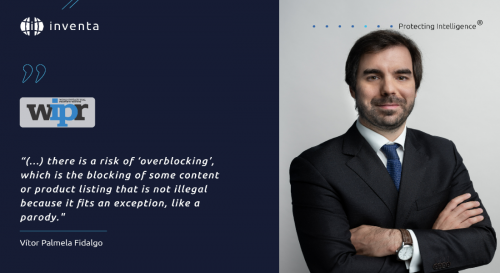
Protecting EU trademarks in the metaverse
The presence of brands in the metaverse, depending on the adopted concept, is not a future fact. Brands are already in the metaverse. If the concept of metaverse is debatable, and so is its present existence, it is at least undeniable that approximate realities already exist. In digital spaces such as, among others, “Roblox”, “Fortnite”, “Second Life” and “Descentraland”, it is possible to sell goods and provide digital services.
Naturally, in recent years, various entities have exercised their freedom of economic initiative in those spaces and have identified their goods and services with their brands. Increasingly, other companies will be interested in doing so.
Protection of registered EU trademarks (EUTM) in the metaverse
The presence of brands in those spaces raises new legal questions. The question addressed in this article is whether an already registered trademark is protected against the registration and use by third parties of an identical or similar trademark, in the metaverse.
Regulation (EU) 2017/1001 of the European Parliament and of the Council of June, 14, 2017 on the European Union trademark, provides that the holder of an EUTM has the right to prevent the use of the same or similar trademark only if used for the same or similar goods and services. The similarity of goods and services is also a requirement for the EUIPO to refuse EUTM applications.
The use of trademarks in the metaverse, and its respective registration, does not, in principle, have any particularity for the analysis of similarity between signs. On the other hand, the analysis of the similarity between goods and services raises new questions. It is questioned, for example, whether the owner of a registered trademark to identify clothing can prevent the use and registration by a third party of an identical or similar trademark to identify digital clothing in the metaverse.
The question here addressed is therefore related to the analysis of the similarity of goods and services, namely, whether digital goods or services should be considered similar to the corresponding non-digital goods and services.
This issue will not be so important in relation to trademarks with reputation status, due to their broader protection, which cover goods and services for which they are not registered. However, the question still stands for most trademarks, as they do not have reputation status.
Some situations do not offer much doubt. For example, if an architecture firm holds an EUTM registration for architectural services, it may prevent the registration and use of its trademark in the metaverse, by a third party, to identify digital real estate design services.
The criteria for comparing goods and services
The solution can only be found in the applicable law. Some situations do not offer much doubt. For example, if an architecture firm holds an EUTM registration for architectural services, it may prevent the registration and use of its trademark in the metaverse, by a third party, to identify digital real estate design services. Even if it is understood that the design services of virtual properties are not included in the architectural services, they will still be design services, which are similar to architectural services.
However, other situations are less clear: should clothing goods, in class 25, be considered similar to digital clothing for metaverse avatars? Should hairdressing services, in class 44, be considered similar to virtual hairdressing services that an entity proposes to provide to the avatar of a user of virtual spaces? Should class 43 restaurant services be considered similar to virtual restaurant services, where metaverse avatars “eat”?
If the question concerns the comparison of goods and services, the answer will be given by the comparison factors established by European case-law.
The Court of Justice of the European Union held, in the Canon case (C-39/97, Canon, 29/09/1998, EU:C:1998:442) that in assessing the similarity of goods all the relevant factors relating to the goods themselves should be taken into account, including, inter alia, their nature, their intended purpose, their method of use and whether they are in competition with each other or are complementary (para 23).
The factors to take into account when comparing goods and services are: nature, intended purpose, method of use, complementarity and competition. Additional factors may be distribution channels, relevant public, and the usual origin of the goods/services.
Regarding the nature of the goods and services, it will be evident that digital goods do not have the same nature as the corresponding non-digital goods. Digital clothing is software. Digital hairdressing services for avatars, will also be downloadable software (class 9) or software as a service (42) or even design services (42). The restaurant services for avatars are also downloadable software (class 9) or software as a service (42) or even entertainment services (41).
The application of the intended purpose factor is done by looking at the purpose of the goods and services. By applying this factor, digital goods and services must also be considered different from the corresponding non-digital. The same happens with the application of the factor of the method of use since the use of goods and services in comparison are different.
There is also no complementarity or competition, and the distribution channels and usual origin are different. In relation to the relevant public, it must be considered that although the end user of the metaverse goods and services can eventually be considered the avatar, the relevant public is the general consumer, the metaverse users. Although the general consumer may be the same for the goods and services being compared, this will not be sufficient to conclude that there is similarity.
Conclusion
It must be concluded that, through the application of the factors of comparison of goods and services, the goods and services marketed and provided in the metaverse, must, in principle, be considered dissimilar to the corresponding non-digital goods and services.
Thus, the holder of an EUTM, which is not a trademark with reputation, covering clothing (class 25), restaurant services (class 43) and hairdressing services (class 44), cannot, in principle, prevent the registration and use of an identical or similar trademark identifying the corresponding digital goods and services in the metaverse.
However, insofar as the aforementioned comparison factors are not exhaustive, other factors more suitable to this new reality may be applied in the future. It should also be borne in mind that the issue depends on the goods and services in question. As seen, digital and non-digital real estate architectural services should be considered similar.
However, if the owner of an EUTM intends to protect and use its trademark in the metaverse, it will be advisable to obtain registration for the corresponding goods and services.
This is a co-published article, which was originally published in the World Intellectual Property Review (WIPR).
Territory List
There are no results for your search.
- Africa
- Algeria
- Angola
- Benin
- Botswana
- Burkina Faso
- Burundi
- Cameroon
- Cape Verde
- Central African Republic
- Chad
- Comoros
- Congo (Republic)
- Côte d'Ivoire
- Democratic Republic of the Congo
- Djibouti
- Egypt
- Equatorial Guinea
- Eritrea
- Eswatini (Swaziland)
- Ethiopia
- Gabon
- Gambia
- Ghana
- Guinea
- Guinea-Bissau
- Kenya
- Lesotho
- Liberia
- Libya
- Madagascar
- Malawi
- Mali
- Mauritania
- Mauritius
- Mayotte
- Morocco
- Mozambique
- Namibia
- Niger
- Nigeria
- Réunion
- Rwanda
- Sao Tome and Principe
- Senegal
- Seychelles
- Sierra Leone
- Somalia
- South Africa
- South Sudan
- Sudan
- Tanzania (mainland)
- Togo
- Tunisia
- Uganda
- Western Sahara
- Zambia
- Zanzibar
- Zimbabwe
- Africa (OAPI)
- Africa (ARIPO)
- Other
- East Timor
- Macao
- Maldives
- Portugal
- European Patent (EPO)
- European Union Trademark (EUTM)
- International Trademark (Madrid System)
- Patent Cooperation Treaty (PCT)




